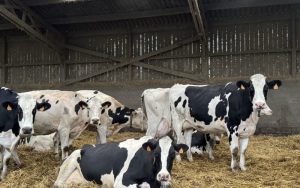
Danone’s recent financial results reveal significant trends for dairy market analysts to consider.
In a context marked by economic challenges and an increasingly complex competitive environment, Danone’s recent financial results reveal significant trends for dairy market analysts to consider.
This article reviews two important stock market reports to analyze the company’s performance, focusing on net income, excluding special items , and return on common stock , metrics that not only provide numbers but also offer insight into the direction of this food giant.
Net profit: between ups and downs
Danone’s net profit, excluding extraordinary items, for the last twelve months was €1.003 billion , a notable decline when compared to the average of €1.515 billion between 2019 and 2023.
Furthermore, when looking at the historical median for the period, which is €1.898 billion , it is clear that the recent results represent a significant contraction.
The five-year high of €1.941 billion in December 2020 contrasted sharply with the low of just €873 million in December 2023, a 7.7% drop from the previous year.
What does this mean for Danone?
This decline reflects the strains facing major dairy players. Factors such as rising production costs, disruptions to global supply chains and shifting consumer preferences towards plant-based alternatives and premium products may be putting pressure on Danone’s margins.
Compared to its competitors, Danone still stands out for its net profit volume.
Companies such as Kerry Group (661.6 million euros) or Ingredion (613.4 million euros) lag behind, although they show less fluctuation in their results.
However, rivals with more aggressive diversification strategies, such as Hershey Co. (€1.589 billion), maintain a more stable competitive advantage.
Return on common shares: an indicator of efficiency and confidence
Danone’s return on common stock (ROE) was 6.0% over the last twelve months, below its historical average of 9.0% and well below its peak of 11.6% in 2020. This decline also puts the company at a five-year low of 5.1% in December 2023.
The comparative analysis reveals a mixed picture. While Danone outperforms Barry Callebaut (6.6%) and Meiji Holdings (6.7%), it lags behind competitors such as Kerry Group (10.3%) and JM Smucker Co. (10.1%). In addition, Hershey Co. dominates the sector with an impressive 43.4% , driven by value-added and diversification strategies.
What does this mean for Danone shareholders?
A falling ROE can be interpreted as a decline in the company’s ability to generate returns on invested capital, which could weaken investor confidence. However, it could also reflect increased investment in innovation or infrastructure, which is needed to adapt to a changing dairy market.
Danone in the context of the global dairy market
Despite the challenging figures, Danone remains a key player in the global market. Its presence in diverse segments, ranging from fresh produce to plant-based beverages, positions it to be resilient in the face of current trends.
Recent financial performance highlights the need to reorient strategies:
- Focus on premium and sustainable products: Consumers are increasingly looking for options that combine quality and environmental responsibility. Danone, with its strong focus on sustainability, can capitalize on this trend by promoting products such as organic yogurts and fermented beverages.
- A drop in net profit suggests that Danone must seek operational efficiencies, whether through digitalization, automation or renegotiating contracts with suppliers.
- Competitors such as Hershey and Kerry Group are aggressively diversifying their portfolios. Danone has an opportunity to strengthen its leadership in emerging segments such as functional foods, where it can differentiate itself through its expertise in probiotics and infant nutrition.
An opportunity amidst challenges
While recent indicators reflect significant pressure on Danone’s margins and efficiency, the company maintains a strategic position in the global dairy sector. The decline in net profit and ROE underscores the urgency of action, but also opens the door to adjustments that could strengthen its long-term competitiveness.
For international market analysts, the main question is whether Danone will be able to redirect its focus to strategic growth areas and regain investor confidence.
Time will tell whether the dairy giant can turn current challenges into a platform for future growth.
The reports analyzed are from investing.com
Valeria Hamann
You can now read the most important #news on #eDairyNews #Whatsapp channels!!!
🇺🇸 eDairy News INGLÊS: https://whatsapp.com/channel/0029VaKsjzGDTkJyIN6hcP1K

























